engine coolant TOYOTA SEQUOIA 2014 2.G User Guide
[x] Cancel search | Manufacturer: TOYOTA, Model Year: 2014, Model line: SEQUOIA, Model: TOYOTA SEQUOIA 2014 2.GPages: 668, PDF Size: 13.86 MB
Page 498 of 668

498 4-3. Do-it-yourself maintenance
Engine coolantThe coolant level is satisfactory if it is between the FULL and LOW
lines on the reservoir when the engine is cold. Reservoir cap
FULL
LOW
If the level is on or below the
LOW line, add coolant up to the
FULL line.
■If the coolant level drops within a short time after replenishing
Visually check the radiator, hoses, reservoir cap, radiator cap, drain cock
and water pump.
If you cannot find a leak, have your Toyota dealer pressure test the cap and
check for leaks in the cooling system.
■ Coolant selection
Only use “Toyota Super Long Life Coolant” or similar high quality ethylene
glycol based non-silicate, non-amine, non-nitrite and non-borate coolant with
long-life hybrid organic acid technology.
U.S.A.: “Toyota Super Long Life Coolant” is a mixture of 50% coolant and
50% deionized water. (Enabled: -31 F [-35 C])
Canada: “Toyota Super Long Life Coolant” is a mixture of 55% coolant and 45% deionized water. (Enabled: -44 F [-42 C])
For more details about engine coolant, contact your Toyota dealer.
Page 499 of 668
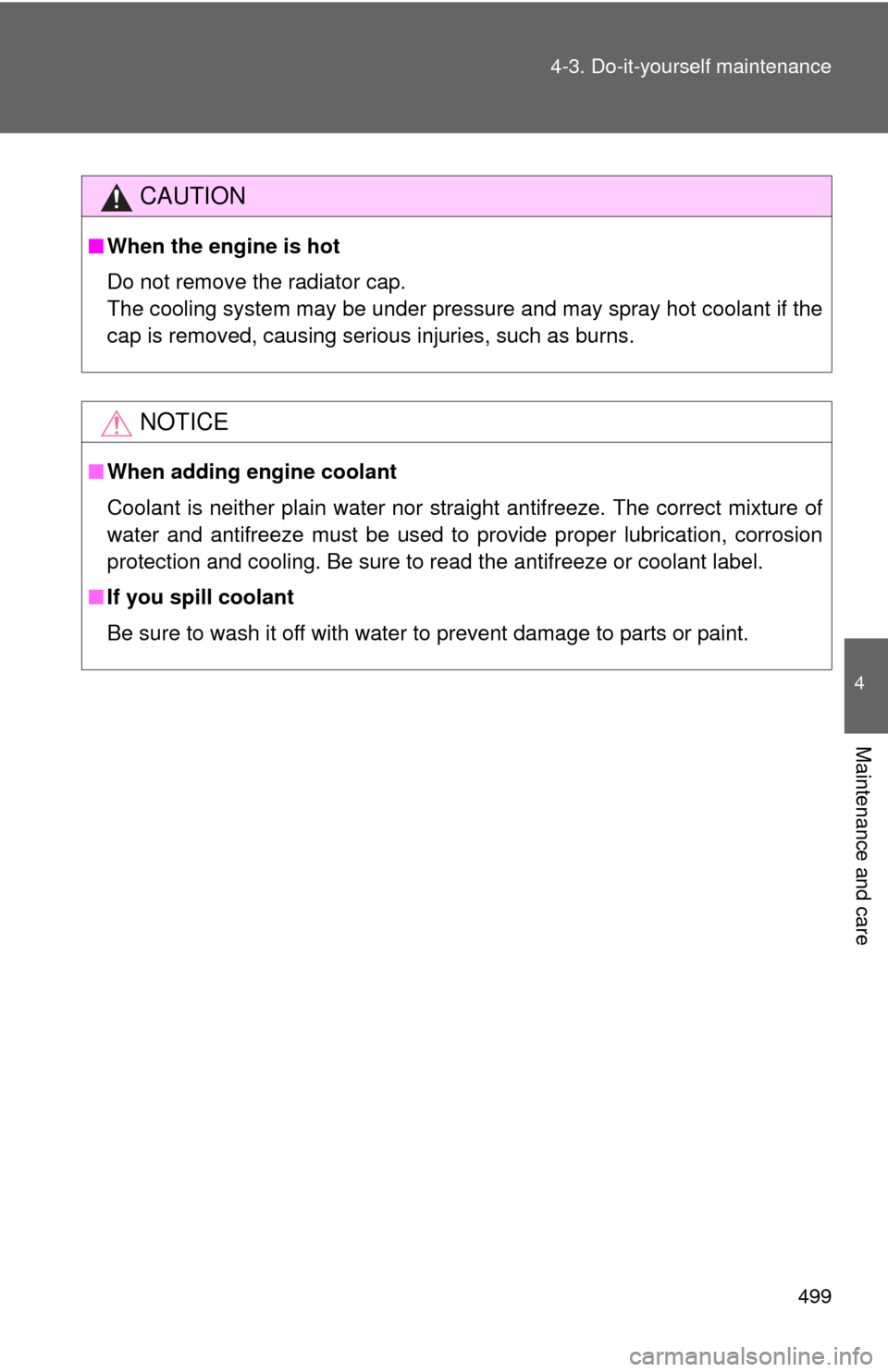
499
4-3. Do-it-yourself maintenance
4
Maintenance and care
CAUTION
■
When the engine is hot
Do not remove the radiator cap.
The cooling system may be under pressure and may spray hot coolant if the
cap is removed, causing serious injuries, such as burns.
NOTICE
■When adding engine coolant
Coolant is neither plain water nor stra ight antifreeze. The correct mixture of
water and antifreeze must be used to provide proper lubrication, corrosion
protection and cooling. Be sure to read the antifreeze or coolant label.
■ If you spill coolant
Be sure to wash it off with water to prevent damage to parts or paint.
Page 559 of 668
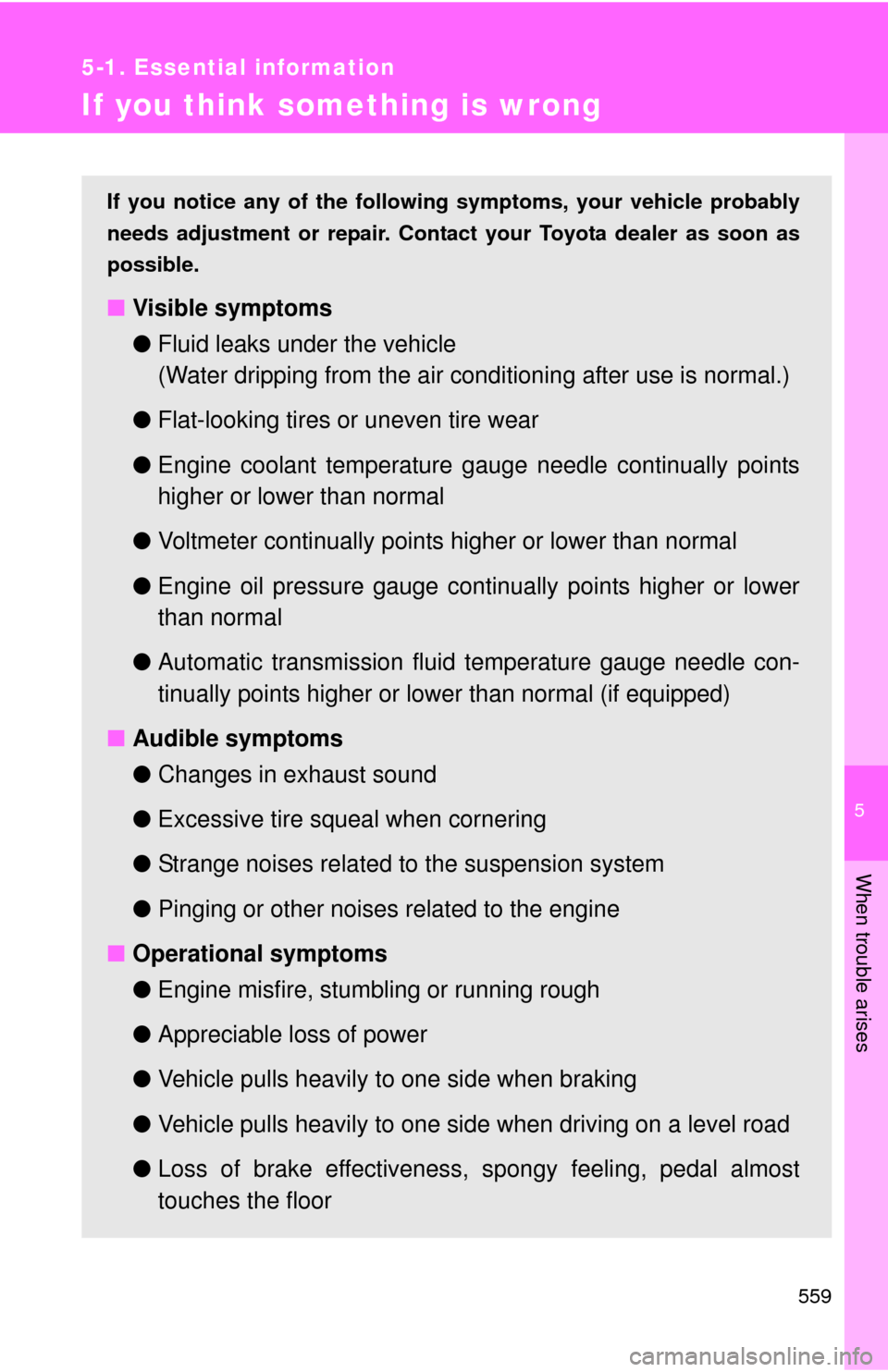
5
When trouble arises
559
5-1. Essential information
If you think something is wrong
If you notice any of the following symptoms, your vehicle probably
needs adjustment or repair. Contact your Toyota dealer as soon as
possible.
■ Visible symptoms
●Fluid leaks under the vehicle
(Water dripping from the air cond itioning after use is normal.)
● Flat-looking tires or uneven tire wear
● Engine coolant temperature g auge needle continually points
higher or lower than normal
● Voltmeter continually points higher or lower than normal
● Engine oil pressure gauge continually points higher or lower
than normal
● Automatic transmission fluid temperature gauge needle con-
tinually points higher or lower than normal (if equipped)
■ Audible symptoms
●Changes in exhaust sound
● Excessive tire squeal when cornering
● Strange noises related to the suspension system
● Pinging or other noises related to the engine
■ Operational symptoms
●Engine misfire, stumbling or running rough
● Appreciable loss of power
● Vehicle pulls heavily to one side when braking
● Vehicle pulls heavily to one side when driving on a level road
● Loss of brake effectiveness, s pongy feeling, pedal almost
touches the floor
Page 572 of 668
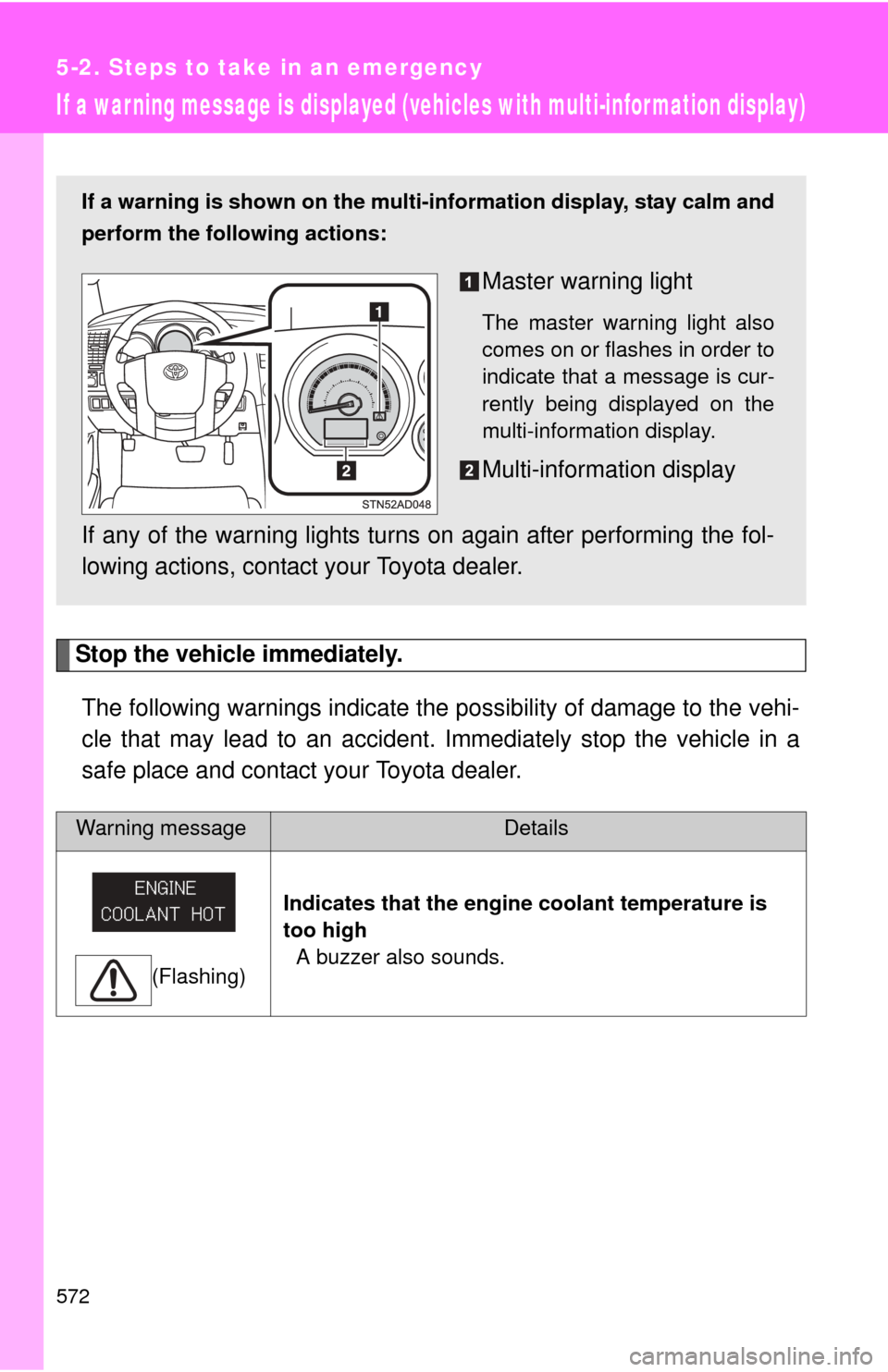
572
5-2. Steps to take in an emergency
If a war ning message is displayed (vehicles with multi-infor mation display)
Stop the vehicle immediately.The following warnings indicate the possibility of damage to the vehi-
cle that may lead to an accident. Immediately stop the vehicle in a
safe place and contact your Toyota dealer.
Warning messageDetails
(Flashing) Indicates that the engine coolant temperature is
too high
A buzzer also sounds.
If a warning is shown on the multi- information display, stay calm and
perform the following actions:
Master warning light
The master warning light also
comes on or flashes in order to
indicate that a message is cur-
rently being displayed on the
multi-information display.
Multi-information display
If any of the warning lights turns on again after performing the fol-
lowing actions, contact your Toyota dealer.
Page 596 of 668
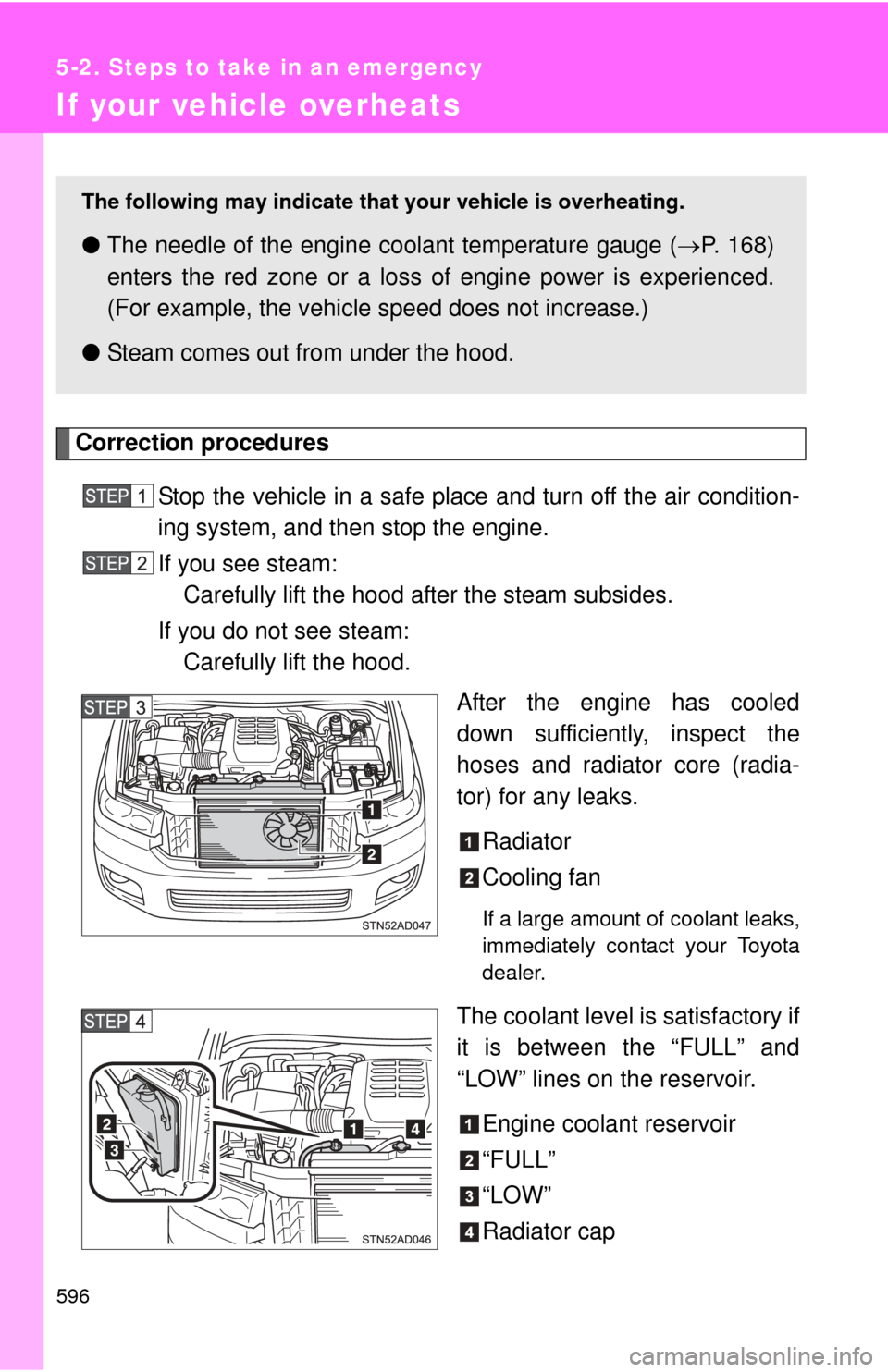
596
5-2. Steps to take in an emergency
If your vehicle overheats
Correction proceduresStop the vehicle in a safe place and turn off the air condition-
ing system, and then stop the engine.
If you see steam: Carefully lift the hood after the steam subsides.
If you do not see steam: Carefully lift the hood.
After the engine has cooled
down sufficiently, inspect the
hoses and radiator core (radia-
tor) for any leaks.
Radiator
Cooling fan
If a large amount of coolant leaks,
immediately contact your Toyota
dealer.
The coolant level is satisfactory if
it is between the “FULL” and
“LOW” lines on the reservoir.Engine coolant reservoir
“FULL”
“LOW”
Radiator cap
The following may indicate that your vehicle is overheating.
●The needle of the engine co olant temperature gauge (P. 168)
enters the red zone or a loss of engine power is experienced.
(For example, the vehicl e speed does not increase.)
● Steam comes out from under the hood.
Page 597 of 668
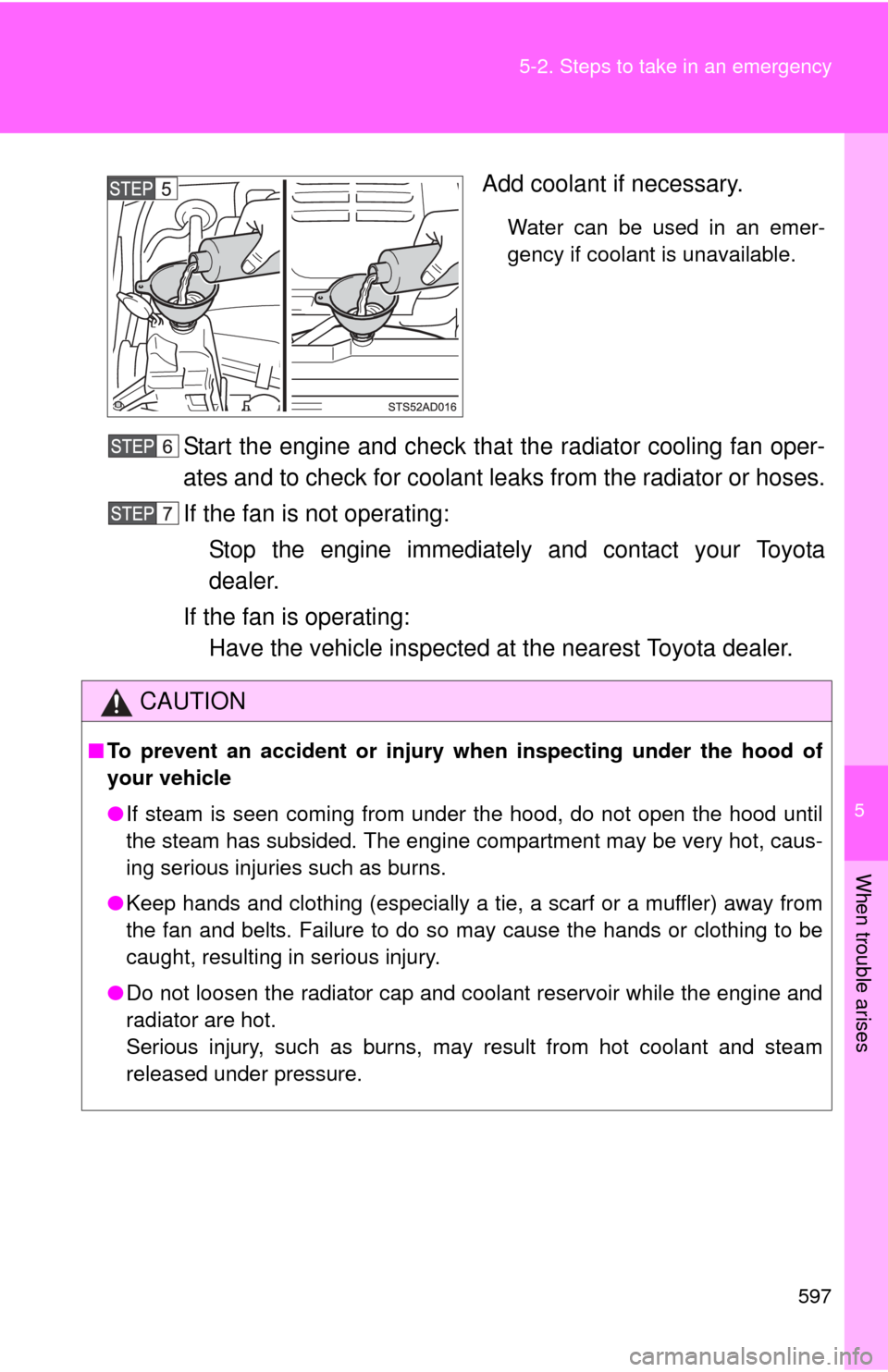
5
When trouble arises
597
5-2. Steps to take in an emergency
Add coolant if necessary.
Water can be used in an emer-
gency if coolant is unavailable.
Start the engine and check that the radiator cooling fan oper-
ates and to check for coolant le
aks from the radiator or hoses.
If the fan is not operating: Stop the engine immediately and contact your Toyota
dealer.
If the fan is operating: Have the vehicle inspected at the nearest Toyota dealer.
CAUTION
■To prevent an accident or injury when inspecting under the hood of
your vehicle
●If steam is seen coming from under the hood, do not open the hood until
the steam has subsided. The engine compartment may be very hot, caus-
ing serious injuries such as burns.
● Keep hands and clothing (especially a tie, a scarf or a muffler) away from
the fan and belts. Failure to do so may cause the hands or clothing to be
caught, resulting in serious injury.
● Do not loosen the radiator cap and coolant reservoir while the engine and
radiator are hot.
Serious injury, such as burns, may result from hot coolant and steam
released under pressure.
Page 598 of 668

598 5-2. Steps to take in an emergency
NOTICE
■When adding engine coolant
Wait until the engine has cooled down before adding engine coolant.
When adding coolant, do so slowly. Adding cool coolant to a hot engine too
quickly can cause damage to the engine.
■ To prevent damage to the cooling system
Observe the following precautions:
●Avoid contaminating the coolant with foreign matter (such as sand or dust
etc.).
● Do not use any coolant additives.
Page 625 of 668

625
6-1. Specifications
6
Vehicle specifications
Warning: The temperature grades for this tire are established for a
tire that is properly inflated and not overloaded.
Excessive speed, underinflation, or
excessive loading, either sepa-
rately or in combination, can caus e heat buildup and possible tire fail-
ure.
Glossary of tire terminology
Tire related termMeaning
Cold tire inflation pres-
sure
Tire pressure when the vehicle has been
parked for three hours or more, or has not
been driven more than 1 mile or 1.5 km under
that condition
Maximum inflation
pressureThe maximum cold inflated pressure to which a
tire may be inflated, s hown on the sidewall of
the tire
Recommended infla-
tion pressureCold tire inflation pressure recommended by a
manufacturer
Accessory weight
The combined weight (in excess of those stan-
dard items which may be replaced) of trans-
mission, power steering, power brakes, power
windows, power seats, radio and heater, to the
extent that these items are available as factory-
installed equipment (whether installed or not)
Curb weight
The weight of a motor vehicle with standard
equipment, including the maximum capacity of
fuel, oil and coolant, and if so equipped, air
conditioning and additional weight optional
engine
Maximum loaded vehi-
cle weight
The sum of:
(a) Curb weight
(b) Accessory weight
(c) Vehicle capacity weight
(d) Production options weight
Page 659 of 668
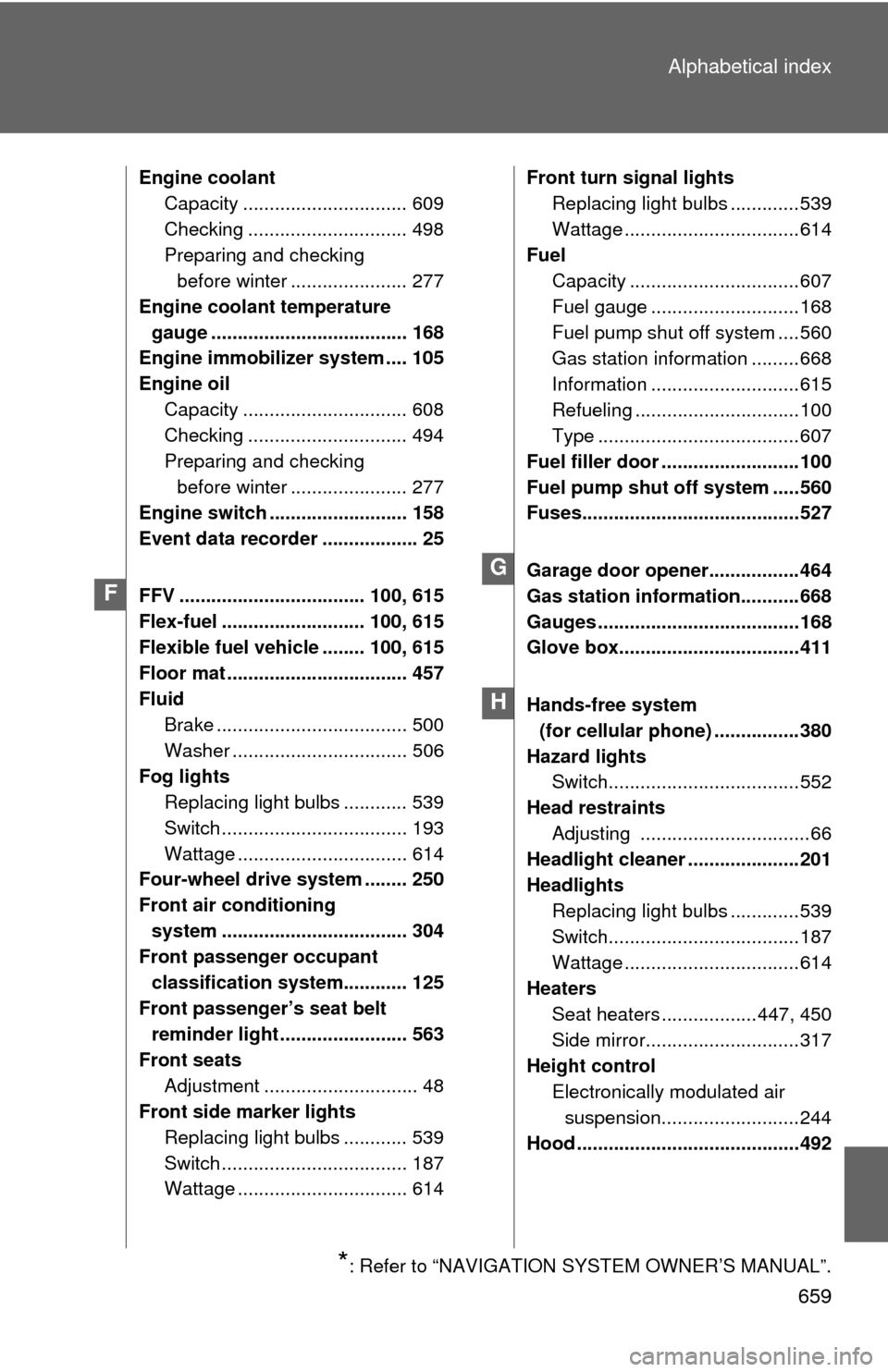
659
Alphabetical index
Engine coolant
Capacity ............................... 609
Checking .............................. 498
Preparing and checking before winter ...................... 277
Engine coolan t temperature
gauge ..................................... 168
Engine immobilizer system .... 105
Engine oil
Capacity ............................... 608
Checking .............................. 494
Preparing and checking before winter ...................... 277
Engine switch .......................... 158
Event data recorder .................. 25
FFV ................................... 100, 615
Flex-fuel ........................... 100, 615
Flexible fuel vehicle ........ 100, 615
Floor mat .................................. 457
Fluid Brake .................................... 500
Washer ................................. 506
Fog lights Replacing light bulbs ............ 539
Switch ................................... 193
Wattage ................................ 614
Four-wheel drive system ........ 250
Front air conditioning
system ................................... 304
Front passenger occupant
classification system............ 125
Front passenger’s seat belt reminder light ........................ 563
Front seats Adjustment ............................. 48
Front side marker lights
Replacing light bulbs ............ 539
Switch ................................... 187
Wattage ................................ 614 Front turn signal lights
Replacing light bulbs .............539
Wattage .................................614
Fuel Capacity ................................607
Fuel gauge ............................168
Fuel pump shut off system ....560
Gas station information .........668
Information ............................615
Refueling ...............................100
Type ......................................607
Fuel filler door ..........................100
Fuel pump shut off system .....560
Fuses.........................................527
Garage door opener.................464
Gas station information...........668
Gauges ......................................168
Glove box..................................411
Hands-free system (for cellular phone) ................380
Hazard lights Switch....................................552
Head restraints Adjusting ................................66
Headlight cleaner .....................201
Headlights
Replacing light bulbs .............539
Switch....................................187
Wattage .................................614
Heaters Seat heaters ..................447, 450
Side mirror.............................317
Height control Electronically modulated air
suspension..........................244
Hood ..........................................492
F
*: Refer to “NAVIGATION SYSTEM OWNER’S MANUAL”.
G
H
Page 665 of 668
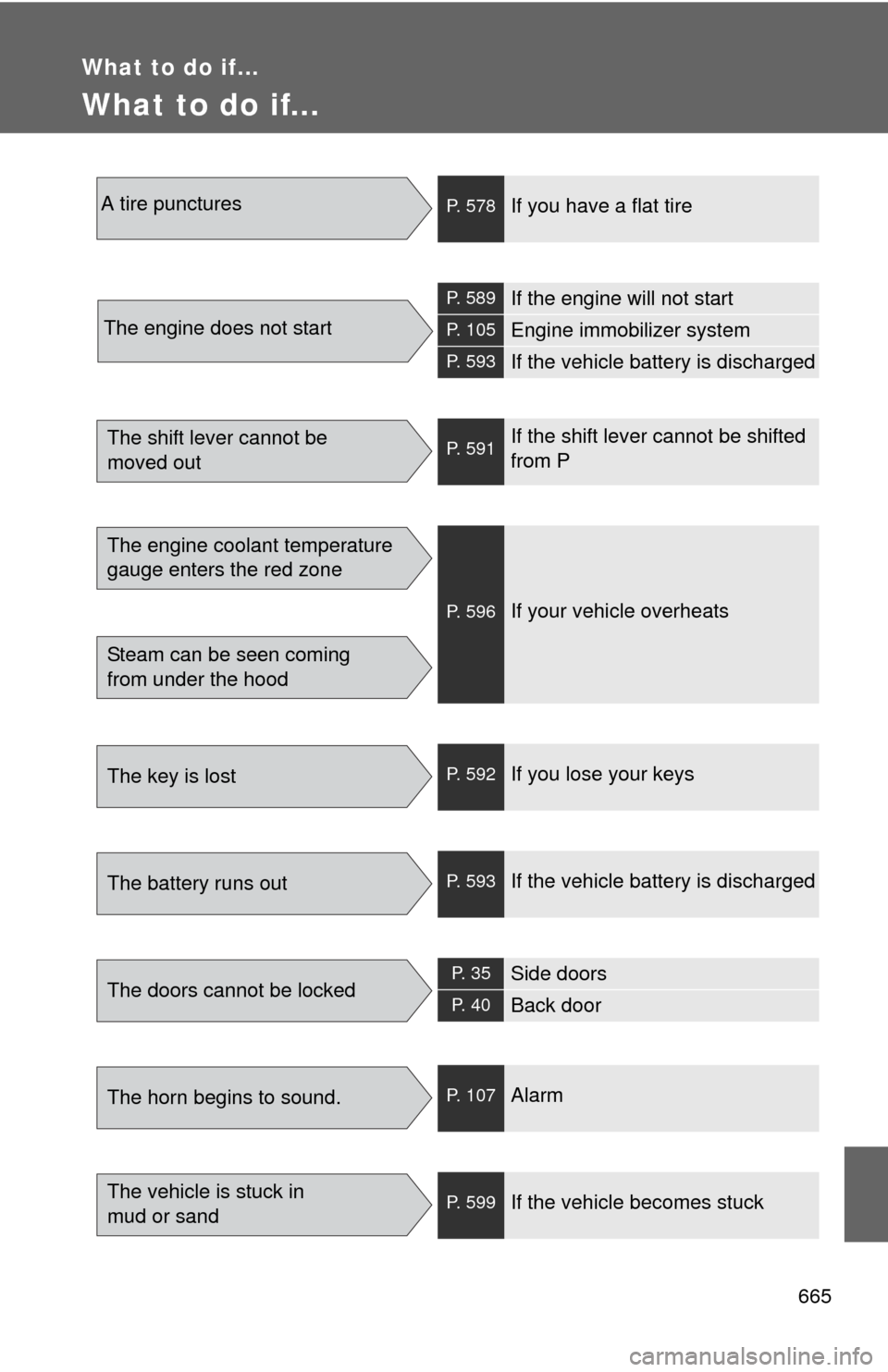
665
What to do if...
What to do if...
A tire puncturesP. 578If you have a flat tire
The engine does not start
P. 589If the engine will not start
P. 105Engine immobilizer system
P. 593If the vehicle battery is discharged
The shift lever cannot be
moved outP. 591If the shift lever cannot be shifted
from P
The engine coolant temperature
gauge enters the red zone
Steam can be seen coming
from under the hood
P. 596If your vehicle overheats
The key is lostP. 592If you lose your keys
The battery runs outP. 593If the vehicle battery is discharged
The doors cannot be lockedP. 3 5Side doors
P. 4 0Back door
The horn begins to sound.P. 107Alarm
The vehicle is stuck in
mud or sandP. 599If the vehicle becomes stuck